With a federal budget on the horizon in Canada we are likely to read and hear a lot more about the "scourge" of income inequality in the coming weeks. It’s true that income inequality in our society exists. Citing this as evidence of a growing gap between rich and poor, however, is the statistician’s equivalent of medical malpractice.
Jobs at the bottom rung of the income ladder are typically entry level, requiring few if any special skills or education. They’re the sort of job that you might take when you first begin working as a teenager. It may be helping part time at the local grocery or flipping burgers at the local McDonald’s. Even if the job does require higher education or training, when you’re young and just starting out, what you earn will typically be at or near the bottom rung of the income ladder.
The question is not what rung we are on when the statistical snapshot is taken, it’s whether or not we are climbing the ladder as we acquire more skills and experience. This is known as income mobility, and measuring it tells a very different story indeed.
According to US Treasury Department data the average earnings of taxpayers who were in the bottom 20 percent of income in 1996 rose 91 percent by 2005. (I use these data because income inequality is perceived to be more acute in America than anywhere else at that time) In contrast to this, the average earnings of those who were in the top 20 percent of income in 1996 rose just 10 percent by 2005, while the average income of those who were in the top 5 percent in 1996 actually declined.
In other words, while the disparity between average incomes of statistical categories grew between 1996 and 2005, this did not, in fact, reflect the actual experience of real people. Those in the bottom 20 percent of earners in 1996 earned their way into higher categories over that 10-year period. For them, the gap between the average income of those in the highest category and their own, shrank. What’s more , many of those who were in the highest category of earners in 1996 found themselves in a lower category by 2005, their places at or near the top taken by others who had been steadily and successfully climbing the income ladder.
There are, of course, individual exceptions to this, but they have little impact on the general pattern.
Similar difficulties arise when interpreting data on distribution of wealth. These data measure only the average or aggregate worth those occupying a statistical category. They do not reflect the actual experience of real people who move into higher categories as they accumulate wealth, while at the same time, people are dropping into lower categories. In other words, it’s a myth that the rich keep getting richer while the poor keep getting poorer. What is actually happening is the “poor” keep getting richer while many of the rich get poorer or, at best, maintain their level of wealth.
None of this real-life experience is evident in the statistics cited by those calling for more government intervention to address inequality. Again, there are individual exceptions to this, but these exceptions do not alter the pattern.
But even if people’s incomes and net worth were static, meaning that individuals never moved from lower to higher categories or vice-versa, the use of these data would still be problematic.
Consider, for instance, the case of a private entrepreneur who owns a manufacturing business. Let’s say that he is a multimillionaire, but all of his wealth is in the value of the factory he owns, or the machinery in that factory. What if he takes little or no salary while he struggles to make his business a success? Is he still rich? It depends on what data you use. If you use income to make that judgment – as those calling for intervention do – you would say that he is poor because his income is at the bottom end of the earnings scale. If, on the other hand, you use net wealth as your standard, you would classify him as rich because of his high net worth. Statistical analysis of the sort we have been discussing solve this dilemma by counting him twice, once as poor, the other as rich, depending on which case they are trying to make.
A similar problem arises when trying to categorize those who don’t work, living instead off of their accumulated savings, like retirees with a pension? These people may have no difficulty making ends meet despite having little or no actual earned income. Are they "rich" because of their relatively high net worth, or are they "poor" because of their low income? Or are they in fact both depending on what criteria you use? And how does this growing segment of the population impact the statistics on income inequality?
As you can see, the issue is far more complex than either Mr. Trudeau or Mr. Singh and their ideological allies in media and academia would have Canadians believe.
Yet another problem with using incomes or net worth to determine relative wealth is that neither take into account the large variance in purchasing power depending on geographic location.
Consider, for instance, the difference in the cost of housing in a large city like New York, Toronto, or Vancouver, and the cost of suburban housing, or housing in smaller towns and villages. A family of four with an annual income of $75,000 living in a small town might well be able to afford housing that is far beyond the reach of someone with ten times that income living alone in Manhattan. And while the net worth of a family that owns a house in Vancouver may be much higher than that of a family that owns a house in a small town – the size of the house and its adjacent property in that small town could easily be vastly superior to that of the house and property in Vancouver, regardless of its dollar-value.
The point is this: Relative wealth simply cannot be determined using statistics on income or net worth. Indeed, because true wealth is a function of standard of living, which is largely subjective – relative wealth cannot be quantified at all, and it’s a fraud to claim otherwise.
A century or so ago, only the very rich could afford a car. Only they could afford that new device called a telephone. The well-off would dine at their exclusive restaurants; they would attend opera and theatre, send their children to good schools, and have access to world-class health care. They enjoyed the benefits of electricity, indoor plumbing, and care-free central heating – meaning that they could pay someone to look after feeding coal into the furnace. They alone lived in good quality houses, enjoyed good quality food, had an extensive wardrobe and could afford to have their hair and nails done on a regular basis.
Today, a century later, the rich – even the mega-rich - enjoy pretty much the same thing…and so does just about everyone else in our society. Today, whether we are statistically rich, poor or somewhere in between, we all have access to all of the things the rich alone used to have, and more.
In short, the evidence is all around us, and it’s irrefutable. Yes, there is a gap between the so-called haves and have-nots in our society, between the rich and poor. But never in human history has that gap been smaller than it is today in all things important and trivial, and despite the periodic fits and starts inherent in a free society with a free economy, that gap, over time, continues to shrink.
Bill Gates might be able to buy the company that made the device you’re reading this on now, but rest assured, if he too is reading, it’s on a device not so different from yours. If unequal distribution of incomes and wealth – as measured in simple dollars - is the price we have pay for this kind of real, as opposed to statistical equality, then I for one say: Vive la difference
Dear Reader,
I don't charge for my content, but...
I do accept voluntary contributions from readers like you who appreciate insightful analysis and value intelligent debate. If you like what you are reading, please consider making a small one-time or monthly contribution by clicking here.




